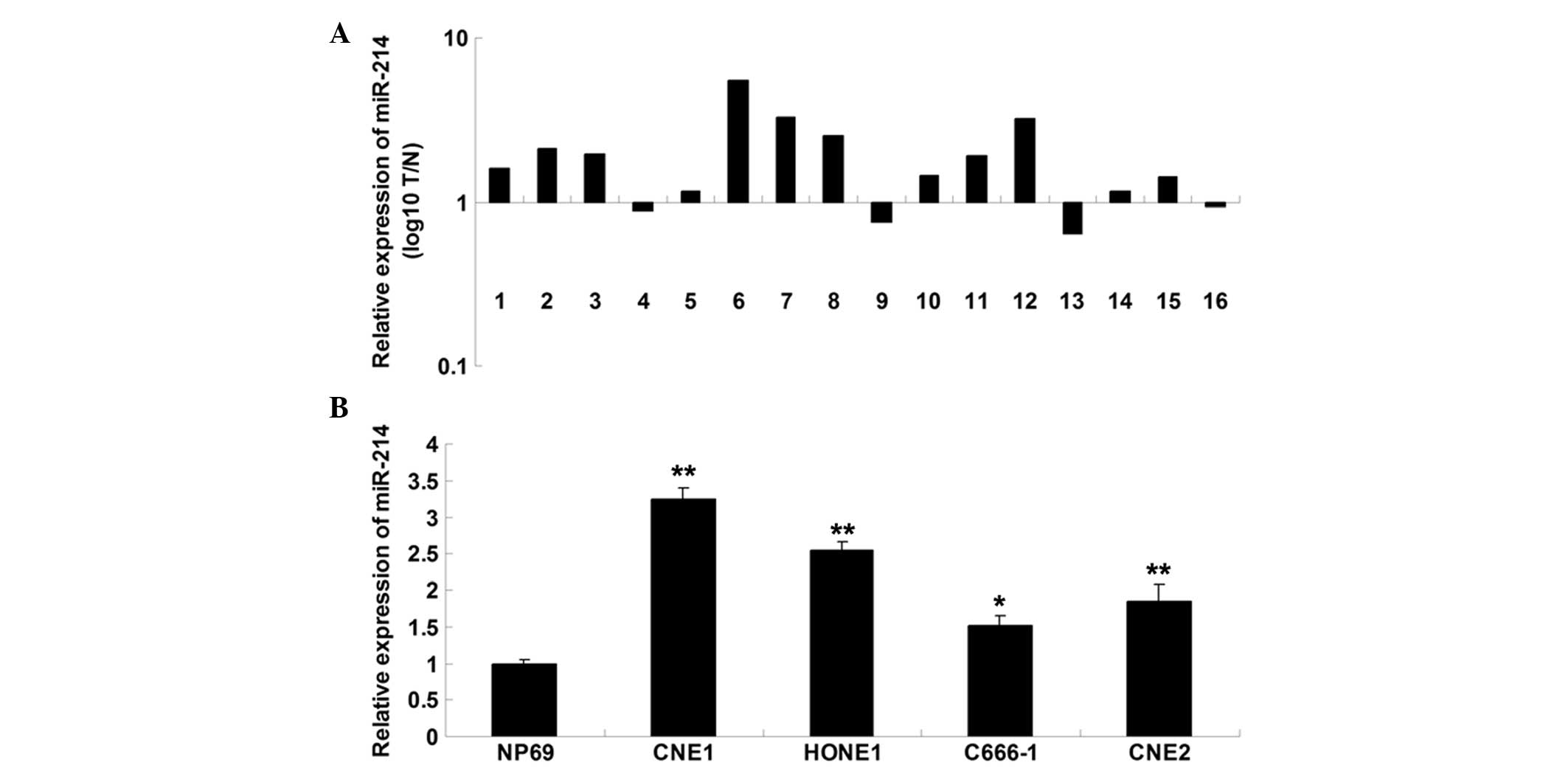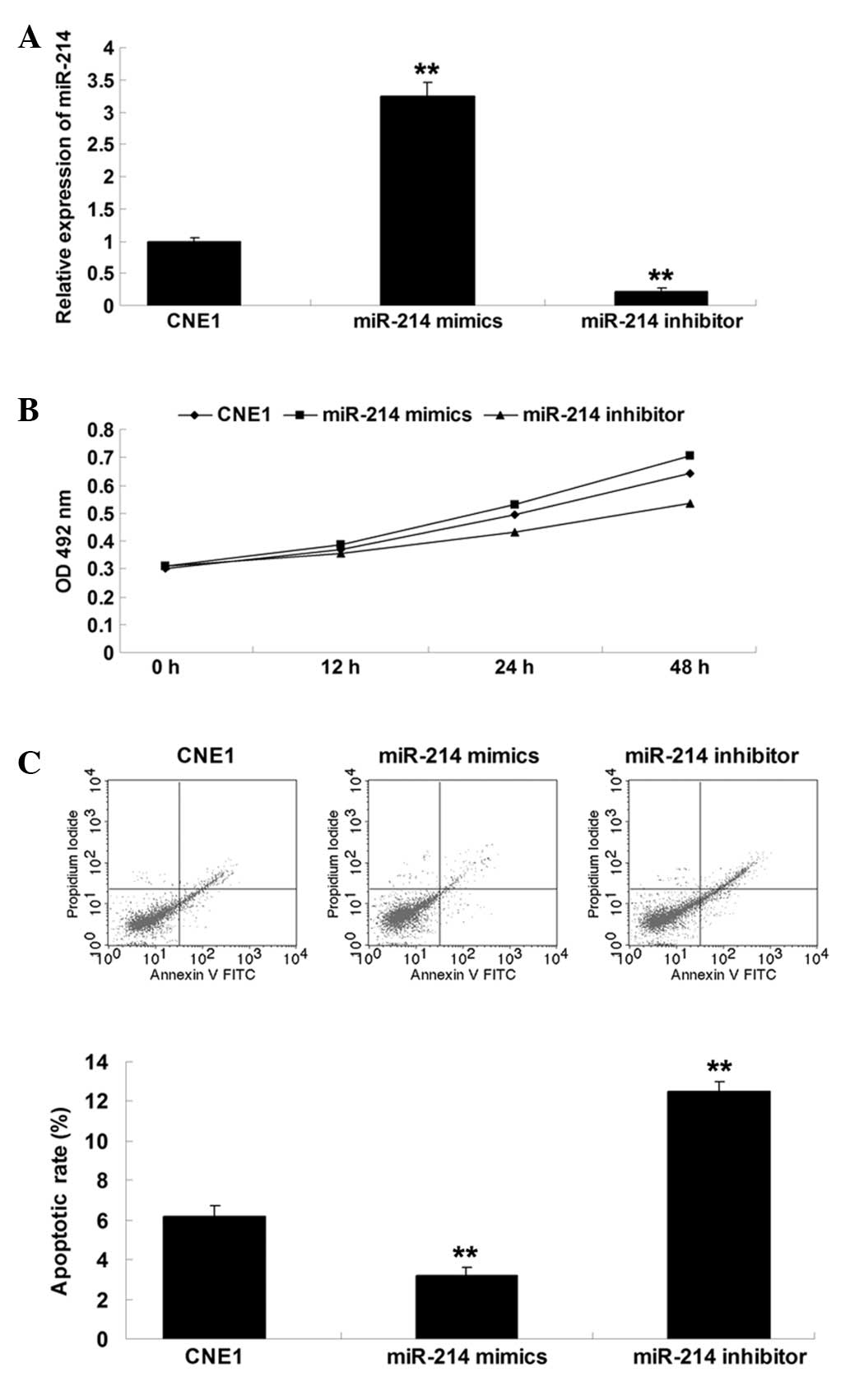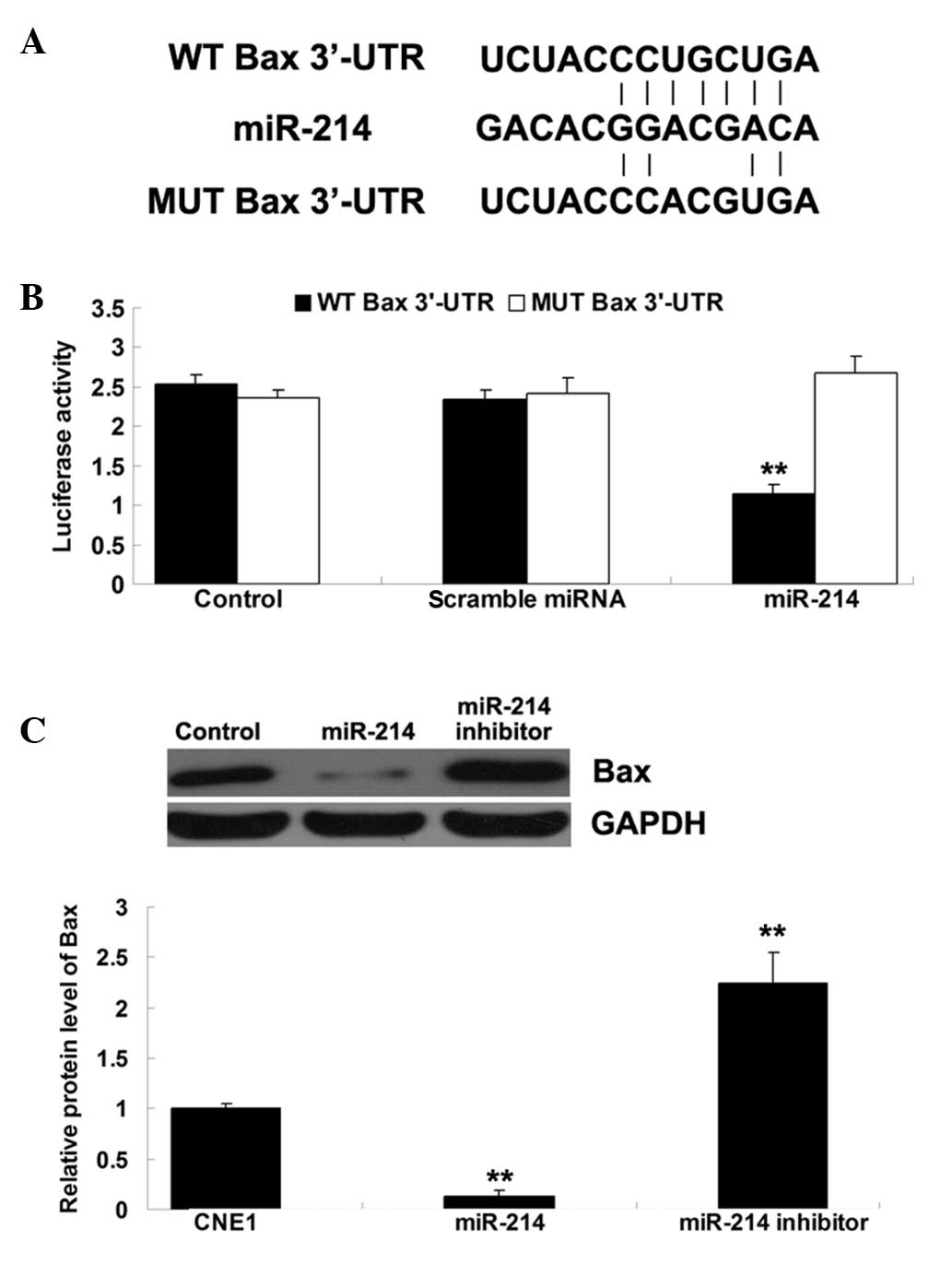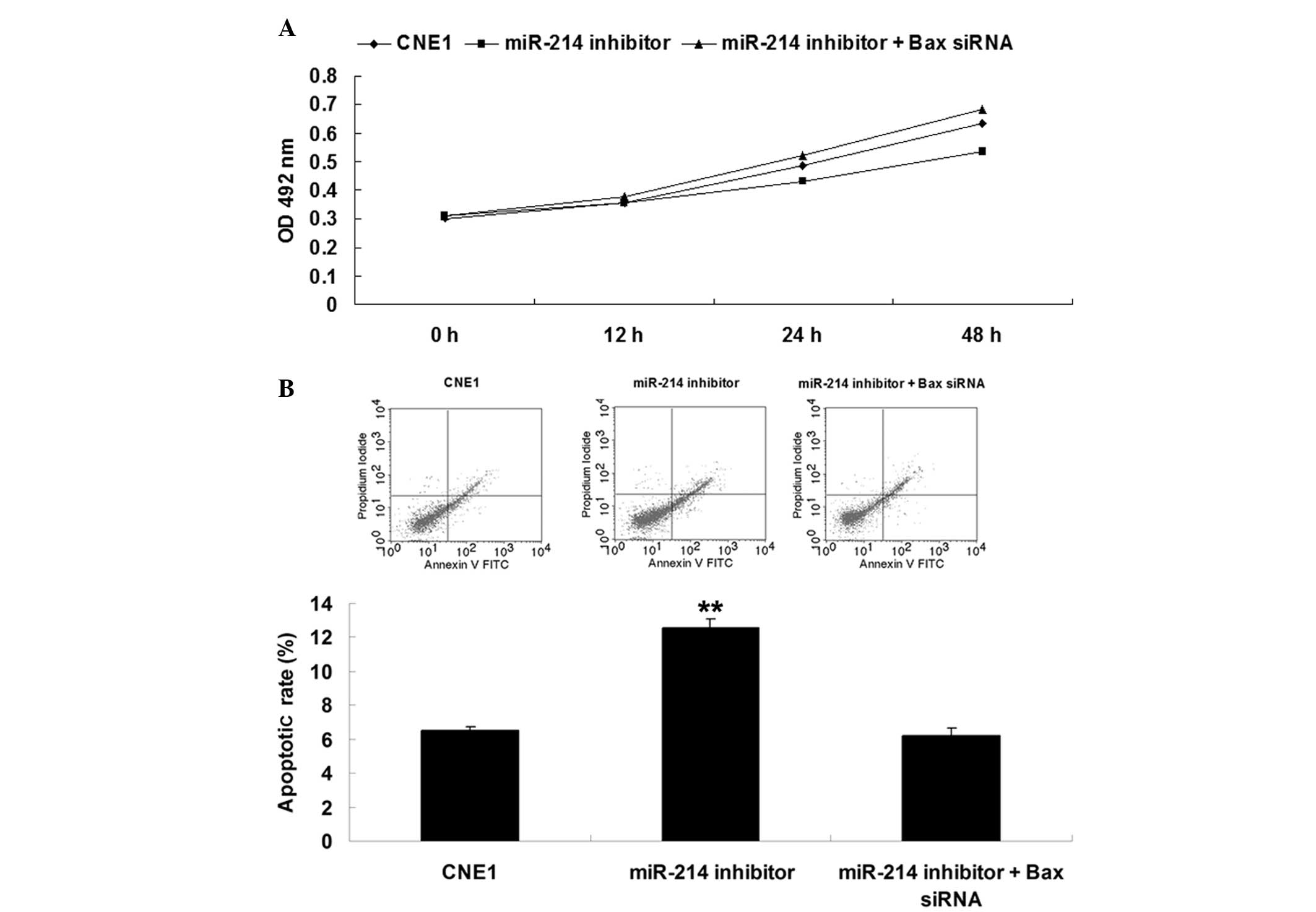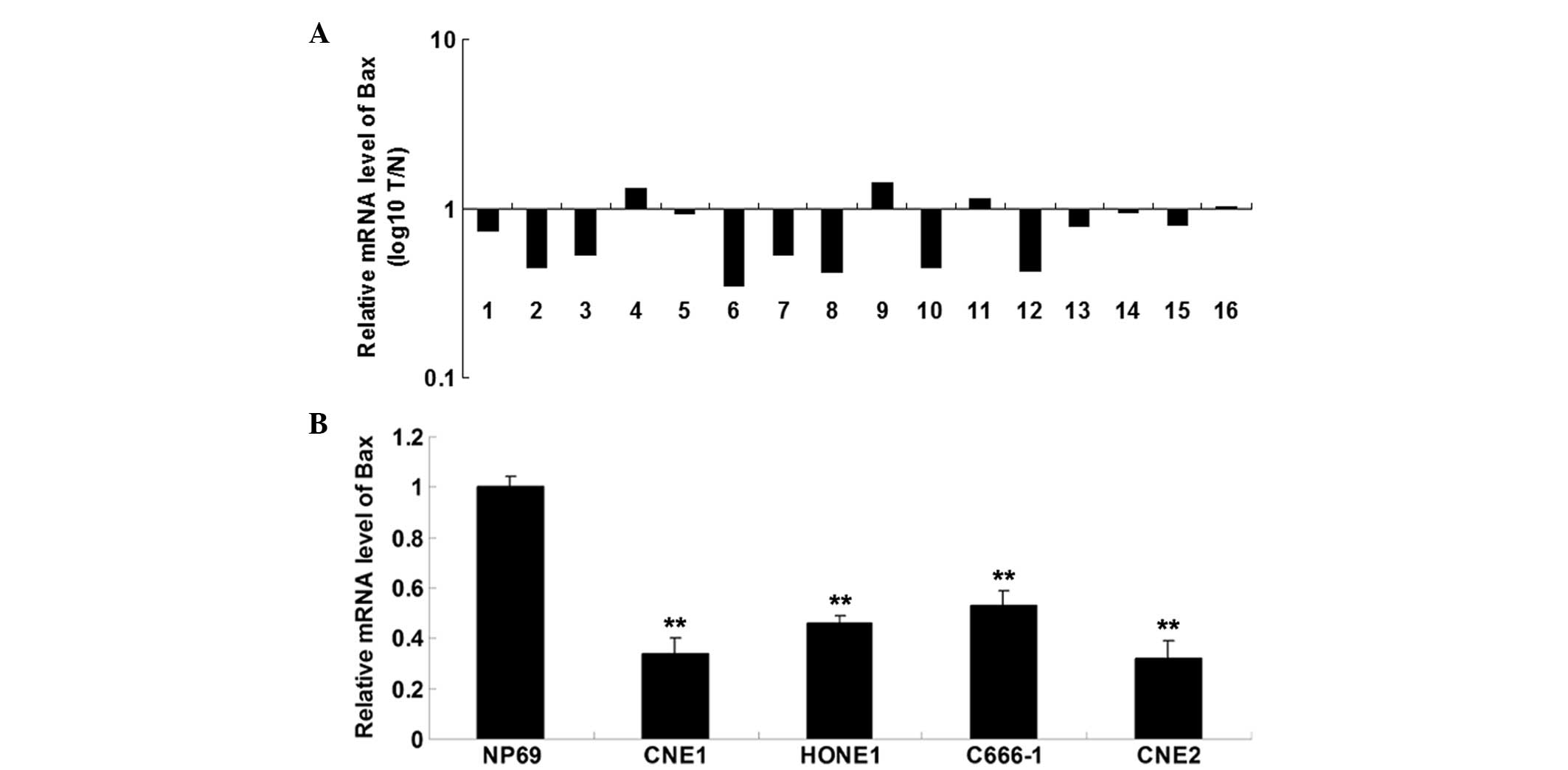MicroRNA‑214 promotes proliferation and inhibits apoptosis via targeting Bax in nasopharyngeal carcinoma cells
Retraction in: /10.3892/mmr.2021.12334
- Authors:
- Published online on: August 3, 2015 https://doi.org/10.3892/mmr.2015.4168
- Pages: 6286-6292
Abstract
Introduction
Nasopharyngeal carcinoma is a relatively rare head and neck cancer worldwide, but is common in southern China and Southeast Asia without a defined etiology. At present, although radiotherapy combined with chemotherapy has enhanced the therapeutic effect of nasopharyngeal carcinoma treatments, the metastatic and relapse rate remain high (1,2). Therefore, novel strategies for the treatment of nasopharyngeal carcinoma are urgently required.
MicroRNAs (miRNAs) are small non-coding RNAs, which can bind to the 3′-untranslated region (3′-UTR) of target mRNA and cause RNA degradation or translation inhibition (3). It has been demonstrated that miRNAs are important in multiple biological processes, including cell survival, proliferation, differentiation and apoptosis (4). miRNAs have been demonstrated to promote or inhibit the development and progression of nasopharyngeal carcinoma, suggesting that miRNAs may function as tumor suppressors or oncogenes (5).
The deregulation of miRNA-214 (miR-214) has been found in multiple types of cancer (6–11). miR-214 has been reported to be upregulated in ovarian cancer, gastric cancer and melanoma, but downregulated in breast cancer, cervical cancer and hepatocellular carcinoma (6–11). In addition, Zhang et al revealed that miR-214 is important in nasopharyngeal carcinoma and found that miR-214 was upregulated in nasopharyngeal carcinoma (12). Silencing of miR-214 promoted apoptosis and suppressed proliferation in nasopharyngeal carcinoma cells, and suppressed tumor growth in nude mice (12). Furthermore, Bim was identified as a direct target of miR-214 and low expression of Bim in nasopharyngeal carcinoma tissues correlated with a poor survival rate of nasopharyngeal carcinoma patients (12). Since one miRNA can have numerous targets, other targets of miR-214 may also exist in nasopharyngeal carcinoma cells.
The present study aimed to investigate the role of miR-214 in the regulation of nasopharyngeal carcinoma cell proliferation and apoptosis, in addition to the underlying molecular mechanisms.
Materials and methods
Reagents
Dulbecco's modified Eagle's medium (DMEM), fetal bovine serum (FBS), TRIzol reagent, MTT, SYBRH Green Master mix, Superscript II Reverse Transcriptase kit and Lipofectamine 2000 were purchased from Invitrogen Life Technologies (Carlsbad, CA, USA). The miRNA reverse transcription-quantitative polymerase chain reaction (RT-qPCR) detection kit was purchased from GeneCopoeia (Rockville, MD, USA). The bicinchoninic acid (BCA) Protein Assay kit and enhanced chemiluminescence (ECL) kit were purchased from Pierce Biotechnology, Inc. (Rockford, IL, USA). The Annexin V-fluorescein isothiocyanate (FITC) Apoptosis Detection kit was purchased from BD Pharmingen (San Diego, CA, USA). The PsiCHECK™2 vector was purchased from Promega Corporation (Madison, WI, USA). A Quick-Change Site-Directed Mutagenesis kit was purchased from Stratagene (La Jolla, CA, USA). Mouse anti-Bax monoclonal antibody (1:50; ab5714) and mouse anti-GAPDH monoclonal antibody (1:100; ab8245) were purchased from Abcam (Cambridge, UK).
Tissue specimen collection
The present study was approved by the Ethical Committee of Central South University (Changsha, China). In total, 16 nasopharyngeal carcinoma tissues as well as their matched normal adjacent tissues were obtained from the Department of Otorhinolaryngology Head and Neck Surgery, Xiangya Hospital of Central South University. Written informed consent from patients with nasopharyngeal carcinoma was obtained. Tissues were frozen in liquid nitrogen following surgical removal and stored at −70°C prior to use.
Cell culture
Four human nasopharyngeal carcinoma cell lines, including CNE1, HONE1, C666-1 and CNE2, as well as the normal nasopharyngeal epithelial cell line NP69 were purchased from the Type Culture Collection of the Chinese Academy of Sciences (Shanghai, China). Cells were cultured in DMEM with 10% FBS and 1% penicillin/streptomycin at 37°C with 5% CO2.
RNA isolation and RT-qPCR
Total RNA was isolated from tissues and cells using TRIzol reagent (Invitrogen Life Technologies) according to the manufacturer's instructions. The concentration of RNA was calculated by measuring the OD260. Reverse transcription of miR-214 and its specific amplification were performed using an miRNA RT-qPCR Detection kit. The relative expression of miRNA was analyzed by the 2−ΔΔCt method. The U6 small nuclear RNA was used for normalization. For determining the expression level of mRNA, total RNA was reverse-transcribed using a Superscript II Reverse Transcriptase kit according to the manufacturer's instructions. Subsequently, PCR was performed with SYBRH Green Master mix using a real-time PCR detection system (ABI 7500; Invitrogen Life Technologies). The following specific primers were used: Bax, forward 5′-CCCGAGAGGTCTTTTTCCGAG-3′ and reverse 5′-CCAGCCCATGATGGTTCTGAT-3′; GAPDH, forward 5′-GGAGCGAGATCCCTCCAAAAT-3′ and reverse 5′-GGCTGTTGTCATACTTCTCATGG-3′. The relative expression of Bax mRNA was calculated by normalization to the GAPDH mRNA level.
Western blot analysis
Tissues or cells were lysed in RIPA buffer containing 1 mM phenylmethylsulfonyl fluoride. Protein was quantified using the BCA Protein Assay kit. The protein sample was diluted, heated for denaturation and then subjected to SDS-PAGE electrophoresis. After the proteins were transferred onto a polyvinylidene difluoride (PVDF) membrane (Millipore Corporation, Billerica, MA, USA), 5% skimmed milk powder was applied for 2 h at 37°C. Subsequently, mouse monoclonal anti-Bax or anti-GAPDH antibodies were incubated for 3 h at room temperature with the PVDF membrane. The PVDF membrane was rinsed in Tris-Buffered saline and Tween 20 three times and then incubated with a fluorescent secondary rabbit anti-mouse IgG antibody (1:10,000; ab46540; Abcam) for 2 h. The PVDF membrane was scanned using an infrared imaging system (Odyssey® CLx Infrared Imaging System; LI-COR Biosciences, Lincoln, NE, USA) and the band intensity was detected using Odyssey analysis software, version 3.0 (LI-COR Biosciences).
Transfection
In accordance with the manufacturer's instructions, transfection was performed using Lipofectamine® 2000 (Invitrogen Life Technologies). For miR-214 functional analysis, cells were transfected with the scrambled miRNA as a negative control, miR-214 mimics or the miR-214 inhibitor. For Bax functional analysis, cells were transfected with Bax-specific siRNA.
Bioinformatics analysis
Bioinformatics analysis was conducted in order to analyze the putative target of miR-214. TargetScan online software (www.targetscan.org) was used for this process.
Luciferase reporter assay
A luciferase reporter assay was performed to determine whether Bax was a direct target of miR-214. In brief, Lipofectamine 2000 reagent was used to transfect CNE1 cells with miR-214 mimics or scrambled miRNA, with either a wild type or mutant type of Bax 3′UTR plasmid, respectively. Renilla and firefly luciferase activities were measured at 48 h post-transfection using the Dual-Glo™ Luciferase Reporter Assay System (Promega Corporation) according to the manufacturer's instructions. The ratio of Renilla to firefly luciferase value was determined.
Cell proliferation analysis
MTT (Invitrogen Life Technologies) was used to perform cell proliferation analysis according to the manufacturer's instructions. Briefly, for each group, 1×104 cells per well were plated in a 96-well plate and incubated for 0, 12, 24 or 48 h at 37°C and 5% CO2. To assess cell proliferation, 10 µl of MTT (5 mg/ml) was added to each well and then incubated for 4 h at 37°C and 5% CO2. The supernatant was removed and 100 µl dimethyl sulfoxide was added to dissolve the precipitation. The absorbance was detected at 492 nm using a microplate reader (FLx800; Biotek Instruments, Inc., Winooski, VT, USA).
Apoptosis analysis
Cell apoptosis analysis was performed using an Annexin V-FITC Apoptosis Detection kit, in accordance with the manufacturer's instructions. In brief, 1×106 cells were resuspended in binding buffer. Following that, 2.5 µl of Annexin V and 5 µl of propidium iodide were added. Following incubation for 15 min in the dark, 400 µl of binding buffer was added. Cell apoptosis was determined by flow cytometry (FACSCalibur; Becton Dickinson, Franklin Lakes, NJ, USA).
Statistical analysis
The results are expressed as the mean ± standard deviation of at least three independent experiments. Statistical analysis of differences was performed by one-way analysis of variance using SPSS 17.0 software (SPSS, Inc., Chicago, IL, USA). P<0.05 was considered to indicate a statistically significant difference.
Results
miR-214 is upregulated in nasopharyngeal carcinoma tissues and cell lines
The expression level of miR-214 was initially examined in nasopharyngeal carcinoma tissues and their matched normal adjacent tissues using RT-qPCR. As shown in Fig. 1A, miR-214 was significantly upregulated in nasopharyngeal carcinoma tissues, when compared with their matched normal adjacent tissues. In addition, miR-214 was also upregulated in nasopharyngeal carcinoma cell lines compared with normal nasopharyngeal epithelial NP69 cells (Fig. 1B).
Inhibition of miR-214 suppresses proliferation and induces apoptosis in nasopharyngeal carcinoma CNE1 cells
As miR-214 was upregulated in nasopharyngeal carcinoma CNE1 cells, miR-214 mimics and an miR-214 inhibitor were used to perform functional analysis of miR-214 in CNE1 cells. As shown in Fig. 2A, the expression of miR-214 was notably decreased following transfection with the miR-214 inhibitor, however, it was increased following transfection with miR-214 mimics. Subsequently, a cell proliferation and apoptosis assay was performed to investigate the role of miR-214 in nasopharyngeal carcinoma CNE1 cells. The data demonstrated that inhibition of miR-214 suppressed proliferation and induced apoptosis in nasopharyngeal carcinoma CNE1 cells (Fig. 2B and C). By contrast, overexpression of miR-214 promoted nasopharyngeal carcinoma cell proliferation and inhibited cell apoptosis (Fig. 2B and C).
Bax is a target of miR-214 in nasopharyngeal carcinoma CNE1 cells
Based on bioinformatical analysis, Bax was found to be a putative target of miR-214 and the putative seed sequences for miR-214 at the 3′UTR of Bax are indicated (Fig. 3A). To further clarify whether Bax was a target of miR-214, plasmids containing the wild and mutant types of the 3′-UTR of Bax were generated (Fig. 3A). A luciferase reporter assay was further performed in nasopharyngeal carcinoma CNE1 cells. The data demonstrated that the luciferase activity was only reduced in nasopharyngeal carcinoma CNE1 cells co-transfected with miR-214 mimics and the wild type 3′-UTR of Bax, but was unaltered in CNE1 cells co-transfected with miR-214 mimics and the mutant 3′-UTR of Bax, indicating that Bax is a target of miR-214 in nasopharyngeal carcinoma CNE1 cells (Fig. 3B).
Following that, the present study investigated whether miR-214 could negatively regulate the expression of Bax in nasopharyngeal carcinoma CNE1 cells. CNE1 cells were transfected with miR-214 mimics or an miR-214 inhibitor, and the protein level of Bax was examined using western blotting. As shown in Fig. 3C, the protein level of Bax was increased following inhibition of miR-214, while it was decreased following upregulation of miR-214, indicating that the protein expression of Bax was negatively regulated by miR-214 in nasopharyngeal carcinoma CNE1 cells.
Inhibition of Bax reverses the effect of miR-214 downregulation on cell proliferation and apoptosis in nasopharyngeal carcinoma CNE1 cells
The present study further determined whether miR-214 had an oncogenic role in nasopharyngeal carcinoma cells through directly targeting Bax. As shown in Fig. 4A, inhibition of Bax notably reversed the inhibitory effect of miR-214 downregulation on CNE1 cell proliferation. In addition, siRNA-mediated Bax inhibition also reversed the promoting effect of miR-214 downregulation on CNE1 cell apoptosis (Fig. 4B). Based on these data, it was suggested that Bax is a downstream effector in miR-214-mediated cell proliferation and apoptosis in nasopharyngeal carcinoma CNE1 cells.
Bax is downregulated in nasopharyngeal carcinoma tissues
The mRNA expression level of Bax was determined. As shown in Fig. 5A, the mRNA level of Bax was decreased in nasopharyngeal carcinoma tissues, compared with their matched normal adjacent tissues. In addition, the mRNA level of Bax was also reduced in nasopharyngeal carcinoma cell lines, when compared with normal nasopharyngeal epithelial cells (Fig. 5B).
Discussion
It is well established that miRNAs are involved in the progression of multiple types of cancer via negatively regulating the protein expression of various target genes (13,14). However, few studies have investigated the deregulation of miRNAs in nasopharyngeal carcinoma. The present study found that miR-214 was upregulated, while Bax was downregulated in nasopharyngeal carcinoma tissues and cell lines. Further investigation suggested that miR-214 promoted proliferation and inhibited apoptosis in nasopharyngeal carcinoma cells via directly inhibiting the protein expression of Bax, a novel target of miR-214 identified in nasopharyngeal carcinoma CNE1 cells.
Aberrant expression of miRNAs has been found to be involved in the development and progression of human nasopharyngeal carcinoma (15,16). The present study reported that the expression level of miR-214 was notably increased in nasopharyngeal carcinoma tissues and cell lines, when compared with their matched normal adjacent tissues and normal nasopharyngeal epithelia cells. Zhang et al also demonstrated that miR-214 was upregulated in nasopharyngeal carcinoma tissues and cell lines (12). In addition, Deng et al reported that miR-214 induced tumorigenesis in nasopharyngeal carcinoma by directly targeting lactotransferrin (17). The present study also revealed that miR-214 had an oncogenic role in nasopharyngeal carcinoma cells. However, to the best of our knowledge, no other target of miR-214 has previously been identified in nasopharyngeal carcinoma cells.
In the present study, it was found that Bax acted as a downstream effector in miR-214-mediated cell proliferation and apoptosis in nasopharyngeal carcinoma CNE1 cells. Bax belongs to the B-cell lymphoma 2 (Bcl-2) protein family, the members of which form hetero or homodimers and act as regulators of cell apoptosis. Bax forms a heterodimer with Bcl-2 and promotes cell apoptosis (18,19). In addition, Bax can increase the opening of the mitochondrial voltage-dependent anion channel and cause a loss in membrane potential, leading to the release of cytochrome c, which is important in cell apoptosis (20). Furthermore the expression of Bax has been demonstrated to be regulated by the tumor suppressor p53 (21). In addition, downregulation of Bax has been demonstrated to be involved in the progression of multiple types of cancer by promoting cancer cell survival (22,23). Bax was also found to be involved in nasopharyngeal carcinoma (24). Li et al demonstrated that overexpression of Bax could induce the apoptosis of nasopharyngeal carcinoma HNE1 cells and prevent growth of implanted tumors (24). Zhang et al reported that Bax inhibitor 1 protein (BI-1), a novel inhibitor of Bax, could induce apoptosis-resistance in nasopharyngeal carcinoma cells and inhibition of BI-1 decreased the ratio of Bcl-X (L)/Bcl-2 with Bax protein and increased the activity of caspase-3, thus leading to a significant increase in nasopharyngeal carcinoma cell apoptosis (23). In the present study, an inverse correlation between miR-214 and Bax expression was found in the nasopharyngeal carcinoma tissues and cell lines. The data also demonstrated that Bax was negatively regulated by miR-214 at the post-transcriptional level, via a specific target site within the 3′-UTR. Furthermore, miR-214 was demonstrated to promote cell proliferation and inhibit cell apoptosis through directly targeting Bax in nasopharyngeal carcinoma cells.
The association between miR-214 and Bax has been reported in hippocampal neurons (25,26). Yan et al found that isoflurane increased vulnerability to intracellular or extracellular amyloid β, which was mediated by the downregulation of miR-214 that leads to an upregulation of Bax (25). Zhang et al also demonstrated that halothane induced neuronal cell death vulnerability by inhibiting miR-214 and upregulating Bax (26). However, to the best of our knowledge, their association in cancer has never been reported. Bax has been demonstrated to be a target of other miRNAs. For instance, miR-128 was found to target Bax and induce apoptosis in human embryonic kidney cells (27). Li et al demonstrated that miR-886-5p could inhibit cervical carcinoma cell apoptosis via targeting Bax (28). In addition, Ji et al found that inhibition of miR-128 sensitized breast cancer cells to chemodrugs by targeting Bax (29). These data suggest that deregulation of Bax by miRNAs is a key mechanism underlying cancer progression.
In conclusion, the present study suggests that the oncogenic role of miR-214 in the regulation of nasopharyngeal carcinoma cell proliferation and apoptosis involves its inhibitory effect on the protein expression of Bax. Thus, miR-214 may be a potential therapeutic target for nasopharyngeal carcinoma.
Acknowledgments
This study was supported by the Fundamental Research Funds for the Central Universities of Central South University (grant no. 2014zzts082).
References
|
Xu T, Tang J, Gu M, Liu L, Wei W and Yang H: Recurrent nasopharyngeal carcinoma: a clinical dilemma and challenge. Curr Oncol. 20:e406–e419. 2013. View Article : Google Scholar : PubMed/NCBI | |
|
Braccini AL, Haberer-Guillerm S, Azria D, et al: Radioanatomy of rhinopharyngeal carcinoma. Cancer Radiother. 17:715–723. 2013.In French. View Article : Google Scholar | |
|
Wright CM, Dan T, Dicker AP and Simone NL: microRNAs: The short link between cancer and RT-induced DNA damage response. Front Oncol. 4:1332014. View Article : Google Scholar : PubMed/NCBI | |
|
Yates LA, Norbury CJ and Gilbert RJ: The long and short of microRNA. Cell. 153:516–519. 2013. View Article : Google Scholar : PubMed/NCBI | |
|
Chen HC, Chen GH, Chen YH, et al: MicroRNA deregulation and pathway alterations in nasopharyngeal carcinoma. Br J Cancer. 100:1002–1011. 2009. View Article : Google Scholar : PubMed/NCBI | |
|
Xu CX, Xu M, Tan L, et al: MicroRNA miR-214 regulates ovarian cancer cell stemness by targeting p53/Nanog. J Biol Chem. 287:34970–34978. 2012. View Article : Google Scholar : PubMed/NCBI | |
|
Wang M, Zhao C, Shi H, et al: Deregulated microRNAs in gastric cancer tissue-derived mesenchymal stem cells: novel biomarkers and a mechanism for gastric cancer. Br J Cancer. 110:1199–1210. 2014. View Article : Google Scholar : PubMed/NCBI | |
|
Penna E, Orso F, Cimino D, et al: miR-214 coordinates melanoma progression by upregulating ALCAM through TFAP2 and miR-148b downmodulation. Cancer Res. 73:4098–4111. 2013. View Article : Google Scholar : PubMed/NCBI | |
|
Derfoul A, Juan AH, Difilippantonio MJ, Palanisamy N, Ried T and Sartorelli V: Decreased microRNA-214 levels in breast cancer cells coincides with increased cell proliferation, invasion and accumulation of the Polycomb Ezh2 methyltransferase. Carcinogenesis. 32:1607–1614. 2011. View Article : Google Scholar : PubMed/NCBI | |
|
Wang F, Liu M, Li X and Tang H: MiR-214 reduces cell survival and enhances cisplatin-induced cytotoxicity via down-regulation of Bcl2l2 in cervical cancer cells. FEBS Lett. 587:488–495. 2013. View Article : Google Scholar : PubMed/NCBI | |
|
Wang J, Li J, Wang X, Zheng C and Ma W: Downregulation of microRNA-214 and overexpression of FGFR-1 contribute to hepatocellular carcinoma metastasis. Biochem Biophys Res Commun. 439:47–53. 2013. View Article : Google Scholar : PubMed/NCBI | |
|
Zhang ZC, Li YY, Wang HY, et al: Knockdown of miR-214 promotes apoptosis and inhibits cell proliferation in nasopharyngeal carcinoma. PLoS One. 9:e861492014. View Article : Google Scholar : PubMed/NCBI | |
|
Brower JV, Clark PA, Lyon W and Kuo JS: MicroRNAs in cancer: Glioblastoma and glioblastoma cancer stem cells. Neurochem Int. 77:68–77. 2014. View Article : Google Scholar : PubMed/NCBI | |
|
Huang JT, Wang J, Srivastava V, Sen S and Liu SM: MicroRNA machinery genes as novel biomarkers for cancer. Front Oncol. 4:1132014. View Article : Google Scholar : PubMed/NCBI | |
|
He ML, Luo MX, Lin MC and Kung HF: MicroRNAs: potential diagnostic markers and therapeutic targets for EBV-associated nasopharyngeal carcinoma. Biochim Biophys Acta. 1825:1–10. 2012. | |
|
Yu BL, Peng XH, Zhao FP, et al: MicroRNA-378 functions as an onco-miR in nasopharyngeal carcinoma by repressing TOB2 expression. Int J Oncol. 44:1215–1222. 2014.PubMed/NCBI | |
|
Deng M, Ye Q, Qin Z, et al: miR-214 promotes tumorigenesis by targeting lactotransferrin in nasopharyngeal carcinoma. Tumour Biol. 34:1793–1800. 2013. View Article : Google Scholar : PubMed/NCBI | |
|
Renault TT, Teijido O, Antonsson B, Dejean LM and Manon S: Regulation of Bax mitochondrial localization by Bcl-2 and Bcl-x(L): keep your friends close but your enemies closer. Int J Biochem Cell Biol. 45:64–67. 2013. View Article : Google Scholar | |
|
Renault TT and Manon S: Bax: Addressed to kill. Biochimie. 93:1379–1391. 2011. View Article : Google Scholar : PubMed/NCBI | |
|
Kumarswamy R and Chandna S: Putative partners in Bax mediated cytochrome-c release: ANT, CypD, VDAC or none of them? Mitochondrion. 9:1–8. 2009. View Article : Google Scholar | |
|
Wu X and Deng Y: Bax and BH3-domain-only proteins in p53-mediated apoptosis. Front Biosci. 7:d151–d156. 2002. View Article : Google Scholar : PubMed/NCBI | |
|
Cory S and Adams JM: Killing cancer cells by flipping the Bcl-2/Bax switch. Cancer Cell. 8:5–6. 2005. View Article : Google Scholar : PubMed/NCBI | |
|
Zhang M, Li X, Zhang Y and Zhou K: Bax inhibitor-1 mediates apoptosis-resistance in human nasopharyngeal carcinoma cells. Mol Cell Biochem. 333:1–7. 2010. View Article : Google Scholar | |
|
Li H, Xie M, Xu G and Li Y: Effect of transduction bax gene on experimental nasopharyngeal carcinoma. Zhonghua Er Bi Yan Hou Ke Za Zhi. 36:430–432. 2001.In Chinese. | |
|
Yan H, Xu T, Zhao H, Lee KC, Wang HY and Zhang Y: Isoflurane increases neuronal cell death vulnerability by downregulating miR-214. PLoS One. 8:e552762013. View Article : Google Scholar : PubMed/NCBI | |
|
Zhang L and Zhang Y: Halothane increases neuronal cell death vulnerability by downregulating miR-214 and upregulating Bax. Int J Clin Exp Med. 6:452–460. 2013.PubMed/NCBI | |
|
Adlakha YK and Saini N: MicroRNA-128 downregulates Bax and induces apoptosis in human embryonic kidney cells. Cell Mol Life Sci. 68:1415–1428. 2011. View Article : Google Scholar | |
|
Li JH, Xiao X, Zhang YN, et al: MicroRNA miR-886-5p inhibits apoptosis by down-regulating Bax expression in human cervical carcinoma cells. Gynecol Oncol. 120:145–151. 2011. View Article : Google Scholar | |
|
Ji S, Shao G, Lv X, et al: Downregulation of miRNA-128 sensitises breast cancer cell to chemodrugs by targeting Bax. Cell Biol Int. 37:653–658. 2013. View Article : Google Scholar : PubMed/NCBI |



